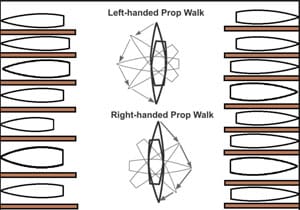 |
|
An important step when making a torque turn is determining the boat's propeller walk. |
|
David Lynn |
One of the useful things we’ve learned while voyaging is a technique called torque turns. These allow you to turn a boat 360 degrees in an area no longer than a boat length. We have employed torque turns on dozens of occasions to turn around our 45-foot Liberty cutter Nine of Cups in a tight marina, or to line the boat up with a slip when there was no maneuvering room.
When making a torque turn, we depend on the boat's propeller walk to help turn the boat. Prop walk is the tendency of the boat to rotate when it is first put in gear, and is much more pronounced in reverse than in forward. If the boat has a right-handed prop (i.e., the prop turns clockwise when viewed from the stern), the prop walk in reverse will cause the stern of the boat to swing to port. Conversely, if the boat has a left-handed prop, the stern will rotate to starboard when the boat is put in reverse.
Nine of Cups has a left-handed prop, so when we put the engine in reverse, the stern of the boat has a tendency to move to starboard. To do a torque turn with Cups, we turn the wheel hard to port, then put the engine in forward. The boat will start moving forward and to port. As soon as we start moving forward, I move the throttle to idle, put the engine in reverse, and then put the throttle at about half full speed. Cups will stop moving forward, but before there is any perceptible movement backwards, the stern will start rotating to starboard. As soon as the boat starts moving backwards, I again move the throttle to idle, shift to forward and apply half throttle. As this process is repeated, Cups will rotate in place in a counterclockwise direction. If your boat has a right-handed prop, you would turn the wheel hard to starboard, and the torque turn will rotate the boat clockwise.
 |
|
Torque turns are useful for maneuvering 360 degrees when there is little room to do so. |
|
David Lynn |
There are a couple of potential complications to keep in mind when doing a torque turn. We've learned the hard way that the wind and current have a major effect on the success of a torque. For example, it is very difficult to turn Cups' bow into even a moderate wind using a torque turn. The best we are able to do is get Cups broadside to the wind while she is being blown downwind. I learned this after we had owned Cups for only a few months, and I was trying to get us out of a tight marina in St. Pete. We provided the evening's entertainment for dozens of cruisers enjoying sundowners at a tiki bar there. I think we could have dropped anchor between two waterside tables and bought a round of drinks while I figured out how to extract us.
Likewise, if there is a current, Cups will do a very nice torque turn while moving down-current at whatever speed the water is moving. I learned this a few months later when I was trying to line Cups up with a Travelift slipway. I did a great torque turn before realizing there was quite a strong current. By the time I got us perfectly aligned, we were about a boat length downstream of the slipway.
In most circumstances, the technique works very well. When it doesn't, I'd like to devise a clever way of quickly covering Cups' nameboards. I need to give that some thought.
David Lynn and his wife, Marcie, have lived aboard their 45-foot 1986 Liberty cutter Nine of Cups since 2000. After departing Kemah, Texas the Lynns have sailed more than 70,000 nautical miles. Their website is www.nineofcups.com.

